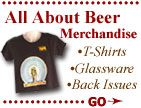
| ||||
| AAB Departments |
| ...Beer Features |
| ...Beer Talk |
| ...Pull Up A Stool! |
| ...What's Brewing |
| ...Beer Travelers |
| ...Stylistically Speaking |
| ...Beer & Food |
| ...Homebrewing |
| ...Collectibles |
| ...Marketplace |
| Beer Lovers' Resources |
| ...World Beer Festival |
| ...Brew Cruise Info |
| ...AAB Merchandise |
| ...AAB Bookstore |
| ...Beer Links |
| About the Magazine |
| ...Subscription Info |
| ...Retail the Magazine |
| ...Advertising Info |
| ...Contact AAB |

|
All About Beer Magazine
Volume 22 Number 5
Homebrewing
The Little Beer of Horrors
Or, How to Host a Wickedly Fascinating Bad Beer Tasting
by Randy Mosher
The cellar door startled the cat with its hoarse creaking, and I felt the rush of cool, earthy air from within. Reaching carefully through the cobwebs, I plucked a seemingly innocent bottle from its long repose and pondered the sleeping golden liquid in the dim subterranean twilight.
With a quick snap of my wrist and a snake-like hiss, the ale obediently slid into my waiting glass. No innocent nymph, this beery banshee fairly shrieked with a chemical so vile, so repulsive as to be pure evil. It was my old nemesis, Phenol.
My anguished cry reverberated throughout the ancient stone grotto, "Whyyyyyyyyyyyyy?"
If something like this--perhaps a bit less Poe-like--has ever happened to you, read on.
Like other metaphysical dimensions of the universe, beer making sometimes shows a darker side. Errors in brewing, biological contamination, and poor storage conditions all may contribute off flavors and aromas to beer. There are a number of fairly common characteristics whose presence is often diagnostic of specific problems.
Learning to recognize the signs of bad beer can be crucial to preventing problems in the future, but more than that, brewing a bad batch is a great opportunity for you to shock and entertain your beery friends with that most feared ritual of zymurgic horror, the Bad Beer Tasting.
Gruesome Fun
It’s not too difficult, and it’s actually kind of fun--if you’re in a gruesome mood (and have some clean ones to drink at the end). Invite brewers and interested non-brewers, and encourage those having bad beers to bring along a sample.
The format is a walk-around, with a number of specially prepared samples as well as problem beers. Some are meant to be tasted, such as beers that are purposefully damaged, or bland (light) beers with flavorings added. Others, because of their noxious nature, are meant for sniffing only. Recipes follow for both.
Label each flavor/aroma flaw sample and place it at an individual station. Provide small disposable cups to ensure that tasters sample only one defect at a time.
Participants go from station to station, noting the flavors and aromas associated with each defect. It is helpful to put out a sheet for notes, so people can share their observations with others. Such impressions can be helpful in recognizing and remembering flavors.
Another station holds defective beers, as yet undiagnosed. More experienced tasters should sample these and decide which category they should be placed into, either an existing category, or a new one (the following is not an exhaustive list), in which case a new label must be made. The rest of the group should taste these diagnosed beers, because the defects often taste different in situ than they do as artificially concocted samples.
Here’s a list of common beer defects--by no means complete--and a suggestion for how to prepare a sample for this tasting.
Diacetyl
This buttery aroma can be desirable in low concentrations in ales, but if it sticks out too far, it’s usually regarded as a defect. Produced by yeast, but especially by certain bacteria. To replicate: Add butter flavor extract (the kind used for baking), 1 to 4 drops or equivalent (1/2 teaspoon? dry to a light lager. Note that quality of diacetyl changes with quantity; for that reason, it might be useful to do a series at different dilutions.
DMS (dimethyl sulfide)
A vegetal aroma that can result from brew house procedure (wort held at high temperatures without boiling, usually) or, in extreme cases, from contamination. Actually regarded as a positive in some European lagers, where, in small quantities, it adds a certain richness. To replicate: Add juice from canned corn to light beer.
Skunkiness (methyl mercaptan)
The result of light hitting dissolved hop compounds, resulting in a rubbery, skunky aroma. To replicate: European beer in green bottle, placed in sunlight for an hour, then chilled and served normally.
Oxidized
A papery, wet cardboard flavor/aroma, the result of over-aged beer, enhanced by overexposure to air during the brewing process. Varies in quality from beer to beer. To replicate: Find the oldest, dustiest European beer in the liquor store. It should have haze or flakes on the bottom (don’t use weizen, because the haze is intentional). Go for beer in brown bottles only, as the ancient green-clad ones are often skunked as well as oxidized.
Goaty/Sweaty
This is not as rare a condition as we would like, both for homebrew and microbrew, although, thankfully, it’s getting rarer. It’s caused by Lactobacillus and Pediococcus bacterial infections, which produce caproic and other organic acids with strong sweaty or animal--goat-like--aromas. To replicate: There are no artificial substitutes, so you’ll have to come up with a bad beer.
Acetaldehyde
This is an apple-scented chemical that can be created by normal yeast, or more intensely (and rarely) by bacterial infection. Interestingly, Budweiser uses this aroma to impart a crispy quality. To replicate: Add to sample beer one small Green Apple Jolly Rancher candy, smashed and dissolved overnight in a little water.
Acetic
A vinegar aroma caused by infection--intentional, in the case of Belgian lambics and sour brown ales--by acetobacteria. To replicate: Put a couple of teaspoons of distilled vinegar in a sample beer.
Strictly Sniffers (DO NOT DRINK)
Phenolic
A broad category of flavor gremlins. The worst of them, an indicator of wild yeast infection, smells like a bandage or electrical fire. Other, more subtle, even pleasant ones, can come from certain yeast strains (weizen) or honey. To replicate: A nice fresh weizen for the clove-like yeast character; or try honey diluted 1:4 in water; or, for the really nasty one, a roll of old-fashioned white adhesive tape, or perhaps a piece of phenolic circuit board, the amber colored kind, freshly broken for intense aroma. Don’t dunk them in beer; just sniff the objects.
Solvent esters
These are produced by yeast at higher temperatures and contribute floral, fruity, spicy notes to ales. In extreme cases, this becomes a solventy character, due to concentrations of ethyl acetate. To replicate: Old-fashioned nail polish remover (unperfumed) or acetone, a few drops in a beer. This is as much a sensation as an aroma; I always feel it as my eyes tearing up long before I actually smell it.
It is obvious, I think, that this is just the beginning of a study of beer flavor defects and their origins. Getting your nose sharpened up is the best place to start, but you’ll probably want to get a little more detail, especially if you’re having a problem with something you identify here. George and Laurie Fix’s books (
Principles of Brewing Science and An Analysis of Brewing Techniques) offer gobs of detail. The organizations listed below can help connect you with organized judging programs, the very best way to go further in this area.Happy sniffing, and don’t let the beer bugs bite!
Resources
BJCP, Beer Judge Certification Program, www.bjcp.org
AHA, American Homebrewers Association, www.beertown.org
And to see what the super-serious tasters do, check out this site that has information about a more professionally prepared set of samples: www.flavoractiv.com.
Randy Mosher is a freelance art and creative director, lecturer, and author of numerous books and articles on beer and brewing.










